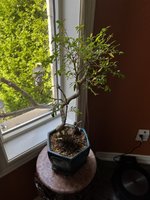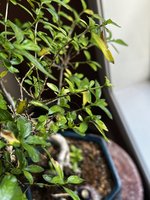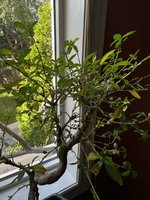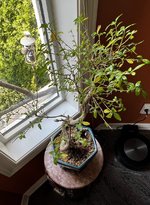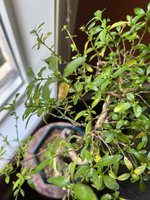When your tree is inside, how much water to give it? A full cup or more? I usually start with a full cup and if I don't see the water coming down through the drains I add a little more until I see it. Before watering once a week, I was watering three times and the leaves were still turning yellow and brown, that's why I cut it back to once a week. I have other Bonsai's, they are not as picky as this one. Sometime I see it flowering but the flower doesn't hold for more than a day or two.
Watering is a difficult topic.
How to water:
When you water, you flood the pot with water. Every square inch of surface should be flooded with water in the process. Water quantity should be enough that water runs out the drainage holes of the pot. You should always water with enough volume of water that water runs out the drainage holes, not just dribble a drop or two.. I often use a bucket of water, and dunk the tree in the water (gently of course) and hold it just barely submerged and watch the bubbles. When the bubbling stops, I remove the tree and set it on a tray to drain (or the sideboard of the kitchen sink). After the pot has drained for a few minutes, I return the pot to its spot where I am growing the tree.
Outdoors, I'll use the garden hose, and repeatedly spray the tree until I see water running out from under the trees. Always water with sufficient quantities of water that the entire volume of the pot is flooded, then allow to drain. Dry pockets can cause problems.
Flooding your trees with water, then allowing to drain is the better technique.
So indoors I either take all my trees to the sink, and water there, or I dunk them in a bucket or pan of water, to at least as deep as the rim of the pot. There is no good way to just dribble water into a pot indoors. Bonsai soils do not wick moisture around like peat based houseplant soils. You must flood all the soil in the pot. Then let it drain.
When to water:
First, the best measuring instruments to determine how wet or dry your soil or potting media is, are the human finger and your eyes. No electronic gadget will work as well in a home setting as using your finger and your eyes. Dig your finger into the potting media at least as deep as the base of your fingernail or first knuckle. If the media feels cool and moist, then no need to water. If the media feels dry, with no noticeable temperature change, then you should have watered a few hours to a day earlier. Goal is to thoroughly drench your plant to get all the media in the pot thoroughly wet. Then you want the tree to dry to the "Just Barely Moist" stage. Bone dry is too dry except for cactus. Barely moist is tricky to learn, the old standard was about the moisture level of pipe tobacco, but hardly anyone smokes a pipe anymore. Key is, most trees will show signs of wilting as they get past the point of ideal dryness. This is where the eyeballs come in, you can with time see whether a tree needs water just by how the leaves are being held. Let a tree dry to wilting, you will have damaged the fine tender roots. But just before wilting there is a slight angle change in the presentation of the leaves. Once you learn to see that, you can tell from across the room or across the yard whether your tree is in urgent need of water.
Really successful bonsai growers do not put their trees on a watering schedule. Key is to check your trees daily, or twice a day especially in hot weather. Temperatures vary daily, humidity varies, cloud cover varies: therefore the time between watering will vary. If you put your trees on a rigid schedule, you are guaranteed to kill them. Check trees to see if they need water once or twice a day, ONLY water if they need to be watered. It might be as often as twice a day in hot, dry, sunny weather. It might be once every week in cool weather. In winter, while fully dormant, I have had trees go 2 months without needing water when stored in my underground well house.
Even trees grown indoors on the windowsill will have variation in how frequently they need water depending on humidity and temperature. A pattern will emerge, and you may be able to predict when you trees will need water. But you need to check frequently, at least daily until you really know your trees.
So check daily, and water only when needed. Frequency of watering will change with the weather.
Water quality:
Water quality is a complex topic. In general, municipal water from most cities is adequate for bonsai. Individual wells usually are good. USDA generally says water with 600 ppm or less total dissolved solids is adequate for most general nursery and greenhouse operations without additional treatment. (specialty plant crops might be exceptions).
Fertilizer:
There are many ways to fertilize. If you are using a liquid fertilizer, or a fertilizer that you dissolve in a liquid, follow the product label directions to make up your solution. Remember, fertilizing is NOT WATERING. Best practice is to water your trees immediately before applying liquid fertilizer solution. Let your trees drain, then apply liquid fertilizer solution, allow to drain again. Then return tree to growing area.
NEVER water a dry to wilting tree with a fertilizer solution. Always water with clear water first. Then you can water with fertilizer after the tree has recovered from the drought stress. Some growers use "Continuous Feeding" programs. In general continuous feeding can lead to problems. Water with clear water at least once every 3rd or 4th watering if you are doing "Continuous Feeding". Doing so will flush out any accumulations of nutrient imbalances and greatly improve the results from the "continuous feeding" program.
So this is a brief class in watering. I've barely touched on the nuances, but key is to wet all the media in the pot when you do water.

